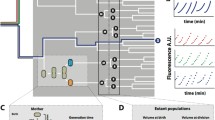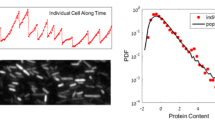Abstract.
In terms of an increment model irreversible thermodynamics allows to formulate general relations of stationary cell size distributions observed in growing colonies. The treatment is based on the following key postulates: i) The growth dynamics covers a broad spectrum of fast and slow processes. ii) Slow processes are considered to install structural patterns that operate in short periods as temporary stationary states of reference in the sense of irreversible thermodynamics. iii) Distortion during growth is balanced out via the many fast processes until an optimized stationary state is achieved. The relation deduced identifies the numerous different stationary patterns as equivalents, predicting that they should fall on one master curve. Stationary cell size distributions of different cell types, like Hyperphilic archaea, E. coli (Prokaryotes) and S. cerevisiae (Eukaryotes), altogether taken from the literature, are in fact consistently described. As demanded by the model they agree together with the same master curve. Considering the “protein factories” as subsystems of cells the mean protein chain length distributions deduced from completely sequenced genomes should be optimized. In fact, the mean course can be described with analogous relations as used above. Moreover, the master curve fits well to the patterns of different species of Archaea, Bacteria and Eukaryotes. General consequences are discussed.
Similar content being viewed by others
References
R.F. Service, Science 284, 80 (1999).
S.A. Kooijman, L.M. Muller, E.B. Stouthamer, Antonie van Leeuwenhoek 60, 159 (1991).
F.W. Schlote, Arch. Microbiol. 40, 283 (1961).
M. Schaechter, O. Maaloe, N. Kjeldgaard, J. Gen. Microbiol. 19, 592 (1958).
N. Kjeldgaard, O. Maaloe, M. Schaechter, J. Gen. Microbiol. 19, 607 (1958).
I. Stewart, Nature 413, 686 (2001).
L. von Bertallanffy, Science 13, 23 (1950).
H. Schindler, V.P. Pastushenko, U.M. Titulaer, Eur. Biophys. J. 27, 219 (1998).
B. Alberts, D. Bray, A. Johnson, J. Lewis, M. Raff, K. Roberts, P. Walter, Essential Cell Biology (Garland, New York, London, 1997) p. 26.
M.F. Perutz, Nature 161, 204 (1948).
H.G. Kilian, R. Kemkemer, H. Gruler, Colloid Polym. Sci. 280, 1151 (2002).
R. Haase, Thermodynamik der Irreversiblen Prozesse (Steinkopf, Darmstadt 1963) p. 118.
H.G. Kilian, M. Koepf, V.I. Vettegren, Prog. Colloid Polym. Sci. 117, 172 (2001).
H.G. Kilian, S. Bronnikov, T. Sukhanova, J. Phys. Chem. B 107, 13575 (2003).
A.M. Turing, Computing Machinery and Intelligence, in Mind 59, 433 (1950).
H.G. Kilian, Prog. Colloid Polym. Sci. 72, 60 (1986).
E. Sackmann, R.F. Bruinsma, ChemPhysChem 3, 262 (2002).
H.G. Kilian, R. Metzler, B.J. Zink, J. Chem. Phys. 107, 8697 (1997).
H.G. Kilian, Colloid Polym. Sci. 280, 661 (2002).
W. Maier, A. Saupe, Z. Naturforsch. 14a, 882 (1959).
P.G. deGennes, The Physics of Liquid Crystals (Clarendon Press, Oxford, 1975) p. 43.
H. Gruler, Z. Naturforsch. 30a, 230 (1975).
R. Haase, Thermodynamik der Mischphasen (Springer, Berlin, 1980) p. 338.
E.W. Montroll, M.F. Shlesinger, J. Stat. Phys. 32, 209 (1983).
D.B. Kell, M.H. Ryder, A.S. Koprelyants, H.V. Westerhoff, Antonie van Leeuvenhoek 60, 145 (1991).
F. van den Ent, L. Amos, J. Löwe, Nature 413, 39 (2001).
Q. Sun, W. Margolin, J. Bacteriol. 180, 2050 (1998).
N. Nanninga, Microbiology 65, 319 (2001).
H.E. Kubitschek, Biophys. J. 9, 792 (1969).
R.E. Ecker, M. Schaechter, Ann. New York Acad. Sci. 102, 549 (1963).
H.G. Kilian, R. Kemkemer, H. Gruler, Prog. Colloid Poym. Sci. 125, 198 (2004).
T. Atlung, Bacterial chromosome replication and the bacterial cell cycle, 2nd ed. (Department of Life Sciences and Chemistry, Roskilde University, 2004).
R. Bernander, A. Poblawski, D.W. Grogan, Microbiology 146, 749 (2000).
F.R. Gross, J. Cell Sci. 12, 117 (1989).
J. Liu, B. Rost, Protein Sci. 10, 1970 (2001).
P.A. Weiss, The Science of Life (Monz Cisco, New York, 1973) p. 276.
Li-Ch Hsieh, L. Luo, H.C. Lee, AAPPS Bull. 13, 22 (2001).
B. Rost, Curr. Opin. Struct. Biol. 12, 368 (2002).
R.K. Scopes, Protein Purification, 2nd ed. (Springer, New York, 1987).
http://www.ebi.ac.uk/integr8/OrganismSearch.do? action=browseOrgs.
R.H. Austin, K.W. Beeson, L. Eisenstein, H. Frauenfelder, I.C. Gunsales, Biochemistry 14, 2355 (1975).
H. Fraunfelder, P.G. Wolynes, R.H. Austin, Rev. Mod. Phys. 71, 419 (1999).
N.G. McCrum, B.E Read, G Williams, Anelastic and Dielectric Effects in Polymer Solids (Wiley, London-New York-Sydney, 1967) pp. 102 and 141.
M. Schienbein, H. Gruler, Phys. Rev. E. 56, 7116 (1997).
Author information
Authors and Affiliations
Corresponding author
Rights and permissions
About this article
Cite this article
Kilian, H.G., Gruler, H., Bartkowiak, D. et al. Stationary cell size distributions and mean protein chain length distributions of Archaea, Bacteria and Eukaryotes described with an increment model in terms of irreversible thermodynamics. Eur. Phys. J. E 17, 307–325 (2005). https://doi.org/10.1140/epje/i2004-10143-8
Received:
Accepted:
Published:
Issue Date:
DOI: https://doi.org/10.1140/epje/i2004-10143-8




